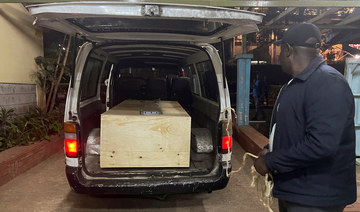ISLAMABAD: The body of Pakistani journalist Arshad Sharif, who was shot and killed by Nairobi police on Sunday, arrived in Islamabad just after midnight Wednesday, as the Pakistan government dispatched a two-member team to Kenya to investigate the murder of the outspoken anchorman.
According to Kenyan police, Sharif was killed when the car he was in sped up and drove through a checkpoint outside the Kenyan capital, prompting police to open fire. Nairobi police say the shooting was being treated as a case of mistaken identity.
The circumstances of Sharif’s death have sparked widespread outrage in Pakistan and calls for an investigation.
Sharif, a hugely popular talk show host, was of late a harsh critic of the current ruling coalition and the army, and fled the country in August, citing threats to his life. He was also widely considered a staunch supporter of ex-Prime Minister Imran Khan and his Pakistan Tehreek-e-Insaf opposition party.
At the time he left Pakistan, he was facing a slew of court cases related to charges of sedition and others. He was believed to have been in the UAE since he left Pakistan and had recently traveled to Kenya.
In a notification issued on Tuesday night, the Pakistani ministry of interior said on the directions of the Prime Minister’s Office, a two-member team had been set up to “ascertain the facts related to the murder of senior journalist Arshad Sharif from Kenyan police and relevant authorities.”
The team includes the Federal Investigation Agency Director Athar Waheed and Intelligence Bureau Deputy Director General Omar Shahid Hamid.
“The team will travel to Kenya immediately,” the circular said, adding that the ministry of foreign affairs and Pakistan’s High Commission in Nairobi would facilitate the visit. It did not specify a timeframe for the team to complete the investigation.
Meanwhile, the slain journalist’s body was received at Islamabad Airport by his family, friends, and a crowd of hundreds of well-wishers early Wednesday morning before being shifted to the morgue at a private hospital in Rawalpindi.
Sharif’s family said he would undergo a post-mortem in Islamabad, and be laid to rest on Thursday at the H-11 cemetery after funeral prayers at 2 p.m. at Islamabad’s Shah Faisal Mosque.
Sharif left Pakistan in August after going into hiding in his own country in July to avoid arrest following a citizen’s complaint against him on allegations of maligning the country’s national institutions, a reference to the military. His whereabouts were not publicly known.
A month later, Sharif’s employer, the private ARY Television, fired him, saying he had violated the TV station’s social media policy. His talk show “Power Play,” which aired on Mondays and Thursdays, was discontinued.
The TV channel had earlier in the year remained critical of Pakistan’s prime minister Shehbaz Sharif following the ouster of his predecessor, Imran Khan, in a no-confidence vote in parliament in April. Khan claimed he was ousted as part of a US plot, a charge both Washington and the Pakistani government deny. Sharif the journalist, who is not related to the PM, had been a prominent critic of Khan’s ouster.
Khan on Tuesday told a gathering of lawyers in the city of Peshawar that he had asked the slain journalist to leave the country as his life was in danger in Pakistan. He paid glowing tribute to Sharif, saying he was among those journalists who never bowed to pressure.
















